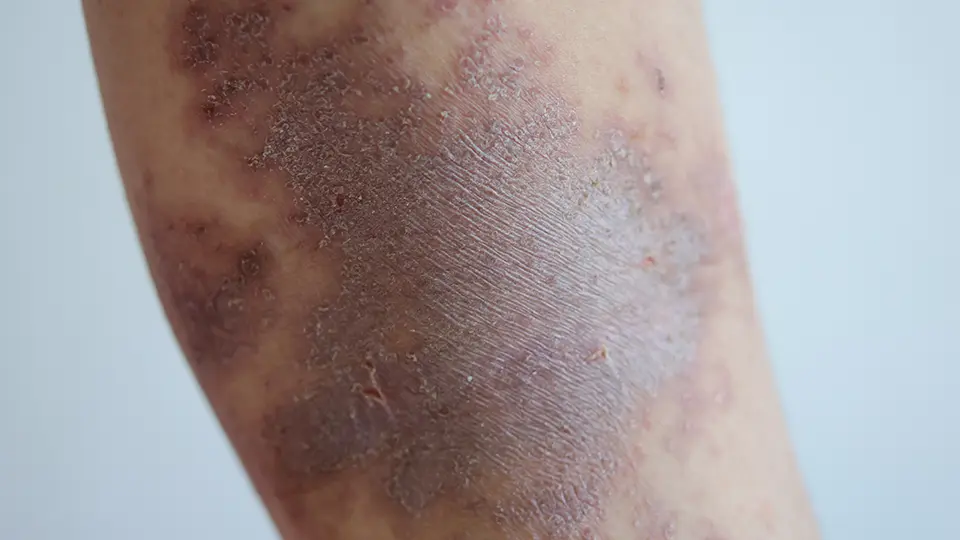Venous Eczema
What is Venous Eczema?
Venous eczema is a condition that affects the legs. The skin becomes red, rough, flaky, and itchy.
It is usually found around the ankles or lower legs and is caused by varicose veins and venous reflux (hidden varicose veins). Although people with varicose veins can usually see them, people with venous reflux (hidden varicose veins) have the same problem with their veins but do not know that they have it, as the veins are hidden deep under the skin.
The most important thing to know about venous eczema is that it is totally curable, provided that is treated correctly by an expert in varicose veins and venous disease. Unfortunately, there is a general lack of understanding about varicose veins and venous reflux disease. Most people (and many doctors and nurses) only diagnose varicose veins if they can see bulging veins on the surface, and if they do see them, they usually dismiss them as “only cosmetic.”


Causes of Venous Eczema
Blood gets pumped from the heart into the legs to keep the tissues oxygenated and supplied with nutrients. Once the blood has got to the feet and lower legs, it has to be pumped back up the legs to the heart. When lying down, this isn’t a problem. However, when we are standing up or sitting down, the feet and ankles are below the heart. Therefore, to get the blood back to the heart, it needs to be pumped up the veins against gravity.
In people with varicose veins or venous reflux (hidden varicose veins), valves in some of the veins stop working. In these people, the muscle contraction and pumping is normal. However, when the muscles relax, the blood falls down the vein that has lost the valves, hitting the small veins and capillaries at the bottom of the vein and causing inflammation.
The inflammation that is caused by the venous reflux,is usually at the bottom of the leg, around the ankle.
The fact that the underlying cause of the eczema is the venous reflux is the reason it is called ‘Venous Eczema’.
If you have followed the above sequence and have understood it, then the treatments become clear and obvious, as do the things that you should avoid.
How is venous eczema treated?
The principle of treatment is easy. As Venous Eczema is caused by blood refluxing the wrong way down the veins that don’t have valves working in them, then stopping this venous reflux cures the condition.
Traditional treatments, including creams and support stockings, temporarily help improve Venous Eczema, but actually do nothing to the underlying cause. If the underlying cause isn’t treated properly, the venous eczema usually progresses. This progression can lead to a worsening of the Venous Eczema, or further skin damage, or even to leg ulceration.
Therefore, the exact treatment each patient needs is tailored individually for them, and the fact that different veins are optimally treated by different combinations of these techniques.
Don’t let vein issues affect your life.
Book a call with us
Treatments for Venous Eczema
Venaseal Glue Treatment
- Can be performed in the office/outpatient environment
- Is relatively painless?
- Very little bruising of the leg
- Minimal local anaesthetic required.
- Return to work within 24 hours.
Radiofrequency Vein Ablation
- Gold standard treatment of varicose veins (along with endovenous laser ablation)
- Keyhole treatment
- Relatively painless and return to work within 24 hours
- Useful in treating primary varicose veins
Closure Treatment
- Same day procedure
- Fast recovery – resuming normal activities within 1-2 days
- Minimal or no scarring
EndoVenous Laser Ablation
- Keyhole treatment
- All varicose vein sizes can be treated.
- Relatively painless with return to work within 24 hours
- Useful in treating primary and secondary varicose veins
Ultrasound – Guided Foam Sclerotherapy
- Keyhole treatment
- Useful in treating recurrent varicose veins
- Outpatient/office based treatment
- Compliments: laser and radio frequency treatment of varicose veins
- Relatively cheap
Vein Check-up
- At the Vein and Foot Clinic, we offer an early detection service for the potential risk of developing thread veins, varicose veins, pelvic varicose veins, and deep vein thrombosis (DVT).
Conditions We Treat
- Varicose veins
- Superficial Venous Thrombosis Phlebitis
- Thread / spider veins
- Swollen leg
- Deep vein thrombosis (DVT)
- May turners syndrome
- Varicose veins in pregnancy
- Varicose veins in obese patients
- Restless leg syndrome
- Varicose veins of the testicles
- Recurrent Varicose Veins
- Hidden Varicose Veins
- Hemosiderin Brown Stains
- Lipo dermatosclerosis (LDS)
- Venous Eczema
- Leg Ulcers
- Vaginal and Vulval Varicose Veins
- Pelvic Congestion Syndrome (PCS)

